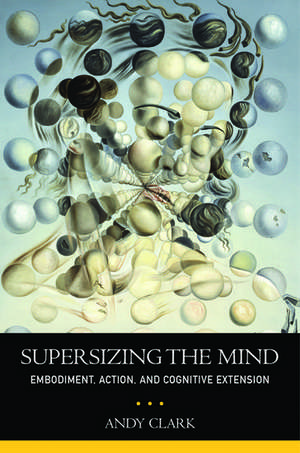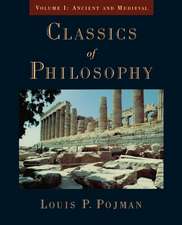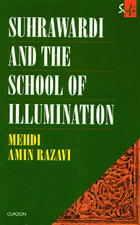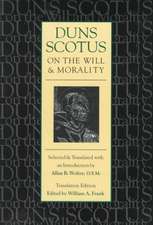Supersizing the Mind: Embodiment, Action, and Cognitive Extension
Autor Andy Clarken Limba Engleză Paperback – 3 feb 2011
| Toate formatele și edițiile | Preț | Express |
|---|---|---|
| Paperback (1) | 190.27 lei 31-37 zile | |
| Oxford University Press – 3 feb 2011 | 190.27 lei 31-37 zile | |
| Hardback (1) | 587.56 lei 31-37 zile | |
| Oxford University Press – 6 noi 2008 | 587.56 lei 31-37 zile |
Preț: 190.27 lei
Preț vechi: 204.30 lei
-7% Nou
Puncte Express: 285
Preț estimativ în valută:
36.42€ • 37.53$ • 30.75£
36.42€ • 37.53$ • 30.75£
Carte tipărită la comandă
Livrare economică 18-24 februarie
Preluare comenzi: 021 569.72.76
Specificații
ISBN-13: 9780199773688
ISBN-10: 0199773688
Pagini: 318
Ilustrații: black & white illustrations
Dimensiuni: 242 x 145 x 18 mm
Greutate: 0.45 kg
Editura: Oxford University Press
Colecția OUP USA
Locul publicării:New York, United States
ISBN-10: 0199773688
Pagini: 318
Ilustrații: black & white illustrations
Dimensiuni: 242 x 145 x 18 mm
Greutate: 0.45 kg
Editura: Oxford University Press
Colecția OUP USA
Locul publicării:New York, United States
Recenzii
brilliant...providing the best argument I've seen for the idea that minds are smeared over more space than neuroscience might have us believe.
Notă biografică
Professor of Philosophy, Edinburgh University. Author of BEING THERE, and NATURAL-BORN CYBORGS (OUP 2003).
Cuprins
Forward: By David Chalmers / Acknowledgements / Introduction: BRAINBOUND versus EXTENDED / I: From Embodiment to Cognitive Extension - 1. The Active Body: 1.1 A Walk on the Wild Side; 1.2 Inhabited Interaction; 1.3 Active Sensing; 1.4 Distributed Functional Decomposition; 1.5 Sensing for Coupling; 1.6 Information Self-Structuring; 1.7 Perception, Qualia, and Sensorimotor Expectations; 1.8 Time and Mind; 1.9 Dynamics and (Soft) Computation.; 1.10 Out from the Bedrock; 2. The Negotiable Body: 2.1 Where the Rubber Meets the Road; 2.2 What's in an Interface?; 2.3 New Systemic Wholes; 2.4 Substitutes; 2.5 Incorporation Vs Use; 2.6 Towards Cognitive Extension; 2.7 Three Grades of Embodiment; 3. Material Symbols: 3.1 Language as Scaffolding; 3.2 Augmenting Reality; 3.3 Sculpting Attention; 3.4 Hybrid Thoughts?;3.5 From Translation to Coordination; 3.6 Second-order Cognitive Dynamics; 3.7 Self-made Minds.;4. World, Incorporated: 4.1 Cognitive Niche Construction: A Primer; 4.2 Cognition in the Globe: A Cameo; 4.3 Thinking Space; 4.4 Epistemic Engineers; 4.5 Exploitative Representation and Wide Computation; 4.6 Tetris: The Update; 4.7 The Swirl of Organization; 4.8 Extending the Mind; 4.9 BRAINBOUND versus EXTENDED: The Case So Far.; II. Boundary Disputes - 5. Mind Re-bound?: 5.1 EXTENDED Anxiety; 5.2 Pencil Me In; 5.3 The Odd Coupling; 5.4 Cognitive Candidacy; 5.5 The Mark of the Cognitive?; 5.6 Kinds and Minds; 5.7 Perception and Development; 5.8 Deception and Contested Space; 5.9 Folk Intuition and Cognitive Extension; 5.10 Asymmetry and Lopsideness; 5.11 Similarity vs Complementarity; 5.12 Hippo-World; 6. The Cure for Cognitive Hiccups (HEMC, HEC, HEMC): 6.1 Rupert's Challenge; 6.2 HEC versus HEMC; 6.3 Parity and Cognitive Kinds (Again); 6.4 The Persisting Core; 6.5 Cognitive Impartiality; 6.6 A Brain Teaser; 6.7 Thoughtful Gestures; 6.8 Material Carriers; 6.9 Loops as Mechanisms; 6.10 Anarchic Self-Stimulation; 6.11Autonomous Coupling; 6.12 Why the HEC?; 6.13 The Cure; 7. Rediscovering the Brain: 7.1 Matter into Mind; 7.2.Honey, I Shrunk the Representations; 7.3 Change Spotting: The Sequel; 7.4 Thinking about Thinking: The Brain's Eye View.: 7.5 Born-Again Cartesians?; 7.6 Surrogate Situations; 7.7 Plug Points; 7.8 Brain Control; 7.9 Asymmetry Arguments; 7.10 Extended in a Vat; 7.11 The (Situated) Cognizer's Innards; III: The Limits of Embodiment - 8. Painting, Planning, and Perceiving: 8.1 Enacting Perceptual Experience; 8.2 The Painter and the Perceiver; 8.3 Three Virtues of the Strong Sensorimotor Model; 8.4 A Vice: Sensorimotor (Hyper) Sensitivity; 8.5 What Reaching Teaches; 8.6 (Tweaked)Tele-Assistance; 8.7 Sensorimotor Summarizing; 8.8 Virtual Content, Again; 8.9 Beyond the Sensorimotor Frontier; 9. Disentangling Embodiment: 9.1 Three Threads; 9.2 The Separability Thesis; 9.3 Beyond Flesh-eating Functionalism. ; 9.4 Ada, Adder, and Odder; 9.5 A Tension Revealed; 9.6 What Bodies Are; 9.7 Participant Machinery and Morphological Computation; 9.8 Quantifying Embodiment; 9.9 The Heideggerian Theatre / 10. Conclusions: Mindsized Bites / Appendix: The Extended Mind (Andy Clark and David Chalmers)













